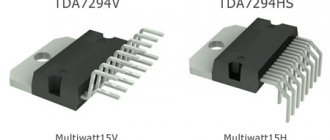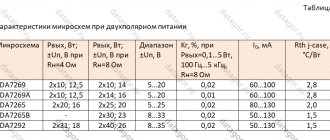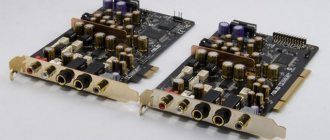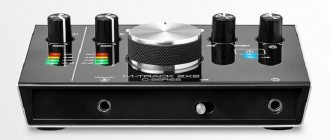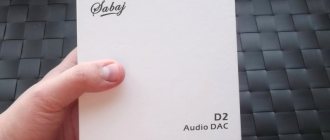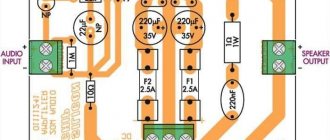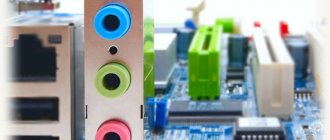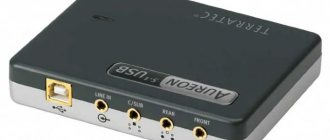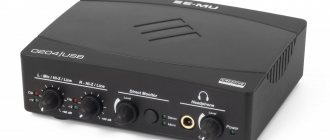Are the oldies here? I'm afraid that few readers can boast that at the dawn of the 90s they had a Creative Sound Blaster sound card in the bowels of their PC. If you had such a card at that time, then you were rich not only materially, but also spiritually. At that time, Creative was the only company that produced a sound card, and in addition also gave the opportunity to connect a joystick to it.
Nowadays you won’t surprise anyone with such tricks. Even the most budget motherboard includes digital surround sound functionality. It would seem, who needs a discrete sound card and for what purpose in the age of high and compact technologies? But, as one classic said, times change, but the demand for high-quality sound always remains!
Creative this summer announced the release of a top model of a discrete sound card, the Sound Blaster AE-9 PCI-EX, and, as you may have guessed, today we will talk about this unique product. We will try to tell you why it is unique.
Specification:
- Sound processor: Sound Core3D
- Main board form factor: PCI-e
- Digital-to-analog converter: ESS Saber 32 ES9038Q2M
- Digital-to-analog converter (DAC): dynamic range (stereo) - 129 dB, THD+N (Stereo) - 0.0001%
- Analog-to-digital converter (ADC): dynamic range (stereo) - 123 dB, THD+N (Stereo) - 0.0004%
- Headers and connections on board: 1 x TOSLINK optical input, 1 x TOSLINK optical output, 1 x 3.5 mm rear speaker output, 1 x 3.5 mm center speaker/subwoofer output, 1 x ACM connector, 1 x 6-pin PCI Express power connector, 2 x RCA (L/R) output for front speakers
- Headphone amplifier on board: output impedance - 1 Ohm; Supported headphone impedance: 16 - 600 ohms, IEM: 16 - 31 ohms (1.5V RMS), Normal: 32 - 149 ohms (3V Rms), High impedance: 150 - 600 ohms (5.3V RMS)
- Playback quality (Stereo): PCM 16 bit; PCM 24 bit; PCM 32bit/44.1/48.0/88.2/96.0/192.0/384.0 kHz, DSD64 (2.8 MHz)
- Playback quality (optical output): PCM 16 bit; PCM 24bit/44.1/48.0/88.2/96.0/192.0 kHz
- Playback quality (5.1 surround sound): PCM 16 bit; PCM 24bit/48.0/96.0/192.0 kHz
- Microphone recording quality: 16 bit; 24 bit; 32bit/44.1/48.0/88.2/96.0 kHz
- Recording quality AUX input: 16 bit; 24 bit /44.1/48.0/88.2/96.0/192.0 kHz
- Recording quality optical input: 16 bit; 24 bit /44.1/48.0/88.2/96.0/192.0 kHz
- Sound quality DSP Mode (stereo and surround sound 5.1): 16 bits; 24 bit; 32bit/44.1/48.0/88.2/96.0 kHz
- On-board power: PCIe bus voltage, +12V for ACM (requires 6-pin PCI Express power connector from PC power supply)
- Main board dimensions: 178 x 22 x 127 mm
- Main board weight: 230g
- Connectors and connections on the Audio Control Module (ACM): Line In - 2 RCA (L/R), 1 x 3.5mm Mic In (Mono), 1 x 3.5mm HP Out (3- pin), 1 x 6.3mm-HP output (3-pin)
- Headphone amplifier on the audio control module (ACM): output impedance - 1 Ohm. Supported headphone impedance: 16 - 600 Ohm, IEM: 16 - 31 Ohm (1.5V RMS). Normal: 32 - 149Ω (3V Rms). High impedance: 150 – 600 ohms (5.3V RMS)
- Audio Control Module (ACM) Dimensions: 150 x 128 x 65 mm
- Audio Control Module (ACM) Weight: 480g
Characteristics:
General characteristics
| Manufacturer | Creative |
| Type | internal with extra block |
| Connection type | PCI-E |
| DAC capacity | 32 bit |
| Need for additional nutrition | There is |
| ASIO support | 2.3 |
| Maximum DAC frequency (stereo) | 384 kHz |
| ADC capacity | 24 bit |
| Maximum ADC frequency | 192 kHz |
| Signal to Noise Ratio DAC | 129 dB |
| Signal-to-noise ratio of ADC | 123 dB |
| THD DAC | 0 % |
| THD ADC | 0 % |
| EAX version | No |
| Possibility of multi-channel audio output | There is |
| Number of RCA input connectors | |
| Number of analogue output channels | |
| Number of analog output connectors | |
| Number of independent headphone outputs | |
| Digital optical S/PDIF input | There is |
| Digital optical output S/PDIF | There is |
Show all specifications Internal sound card with optional Creative AE-9 PE unit
Package
A small box made of massive and thick cardboard looks quite modest at first glance, but when you look at the price tag of this device, you understand that inside there is not much, not little - a compact treasure.
Most of the packaging is replete with not only photographs of the board with a control module, but also a detailed description of the configuration, technical parameters and additional information about support for various sound formats.
On the front of the package there is a board with a control module or ACM - Audio Control Module. The device name and company logo are printed at the top. From the brief description at the bottom, you can understand that in our hands we have a PCI-E audio board with a DAC (digital-to-analog converter), satisfying the most demanding audio lovers, with a XAMP BI headphone amplifier and an external control module for convenience.
Upon opening the packaging, confirmation of the high quality of the product immediately becomes visible. The AE-9 board is packaged in antistatic cellophane and is protected in foam with an exact shape to the size and shape of the board. The next layer, just below, in the same protection is the control module. The included black cardboard case contains cables and additional waste paper. All elements are packed in the box according to size, without gaps and do not dangle when transported.
Reviews Internal sound card with additional unit Creative AE-9 PE:
Add a review without registering
Show all reviews Internal sound card with additional unit Creative AE-9 PE
At Diamond Electric you can buy an internal sound card with an additional Creative AE-9 PE unit at a promotional price. Characteristics and customer reviews. Delivery and pickup in Moscow and other Russian cities. Price 32980 rub.
Information is up to date
You may also be interested in:
Articles Diamond Electric
15.02.2022 17:42
643
Vitaly (diamondelectric.ru)
Realme Narzo 50 reveals some specifications ahead of its announcement
It is expected that Realme Narzo 50 will be launched in India soon. On the eve of this event, new data about RAM and some capabilities of the device has leaked online. Mukul Sharma Read more…
28.01.2022 11:58
1 461
Yuri (diamondelectric.ru)
The key characteristics of RED MAGIC 7 have become known
The RED MAGIC 7 gaming smartphone will be released in February. The company has now released a video celebrating Chinese New Year. The video shows the design of the back of the RED MAGIC 7. The video Read more…
14.01.2022 15:50
1 965
Yuri (diamondelectric.ru)
TECNO POVA Neo will be announced in India on January 20
According to TECNO's official Twitter account, TECNO POVA Neo will be launched in India on January 20th. The tweet suggests that the phone will hit stores on the same day. Since the device Read more…
Popular Creative
- Creative Sound Blaster Audigy Fx Price: 3473 rub. Delivery: Moscow
- Creative Sound BlasterX G5 Price: 9193 rub. Delivery: Moscow
- Creative Sound BlasterX G1 Price: 2804 rub. Delivery: Moscow
- External sound card Creative Sound BlasterX G6 Price: RUB 15,513. Delivery: Moscow
- Internal sound card Creative Sound BlasterX AE-5 Plus Price: RUB 25,663 Delivery: Moscow
- Sound card Creative Sound Blaster GC7 Price: RUB 14,446. Delivery: Moscow
- Sound card Creative Sound Blaster X4 Price: 11,845 rub. Delivery: Moscow
New Creative
- Soundbar Creative BlasterX Katana 51MF8245AA000 Price: more details rub. Delivery: Moscow
- Sound card Creative Sound BlasterX AE-9 5.1 Ret 70SB1780 Price: more details rub. Delivery: Moscow
- Sound card Creative Sound Blaster GC7 Price: RUB 14,446. Delivery: Moscow
- Internal sound card Creative Audigy Rx (sb1550) Price: 5023 rub. Delivery: Moscow
- Creative USB-C Sound Blaster Play! 4 2.0 Ret Price: more details rub. Delivery: Moscow
- Sound card Creative Sound Blaster X4 Price: 11,845 rub. Delivery: Moscow
- External sound card Creative Sound Blaster GC7 Price: RUB 14,446. Delivery: Moscow
New products in the category Sound cards
- External sound card Shure ANI22-XLR Price: more details rub. Delivery: Moscow
- USB audio interface MOTU M2 Price: RUB 23,513 Delivery: Moscow
- External sound card Audient EVO Start Recording Bundle Price: more details rub. Delivery: Moscow
- Sound card for computer RME HDSPe RayDat Price: RUB 67,662. Delivery: Moscow
- Sound card ESI U168 XT Price: RUB 32,903. Delivery: Moscow
- Universal Audio External DSP board UNIVERSAL AUDIO UAD-2 Satellite USB OCTO Core Price: more details rub. Delivery: Moscow
- MOTU Motu 8pre Price: more details rub. Delivery: Moscow
Top sellers in the Sound cards section
- Creative Sound BlasterX G1 Price: 2804 rub. Delivery: Moscow
- ASUS Xonar AE Price: 3660 rub. Delivery: Moscow
- External sound card Creative Sound BlasterX G6 Price: RUB 15,513. Delivery: Moscow
- Internal sound card ASUS Xonar SE Price: RUB 3,443. Delivery: Moscow
- External sound card ASUS Xonar U7 MKII Price: 6152 rub. Delivery: Moscow
- External sound card Focusrite Scarlett 2i2 3rd Gen Price: RUB 12,923 Delivery: Moscow
- External sound card Focusrite Scarlett Solo 3rd Gen Price: 4073 rub. Delivery: Moscow
Private ads +Post an ad
- Nesterov Author: Ilya Date: 11.20.2021 Price: 10,000 rub. Delivery: Moscow
- Sikkens facade paint 20 liters new Author: Ksenia Date: 11/10/2021 Price: 15,000 rub. Delivery: Moscow
- Sewing machine Janome escape V15 Author: Anastasia Date: 09.24.2021 Price: 11,990 rub. Delivery: Moscow
- Facade and interior paints Author: Tair Date: 07.29.2021 Price: 100 rub. Delivery: Moscow
- TEKTOR 101 sealant and adhesive foam Author: Tair Date: 07.17.2021 Price: 450 rub. Delivery: Moscow
- Facade thermal panels from Author: Tair Date: 07.17.2021 Price: 400 rub. Delivery: Moscow
Shops in Moscow Type: Pickup point: PickPoint: Balaklava: daily Address: Moscow, Balaklava pr., 5
Type: Pick-up point: StroyTsentr Lefortovo: daily Address: Moscow, 2nd Kabelny proezd, 1, office 4
Type: Pick-up point: TD Belochka: Citylin: daily Address: Moscow, Shipilovsky proezd, vl. 39, room 3A
Type: Pickup point: PickPoint: Generala Kuznetsova: daily Address: Moscow, Generala Kuznetsova st., 15, building 1
Type: Pick-up point: PickPoint: Luchnikov: daily Address: Moscow, Luchnikov lane, 4, building 2, office 16
Appearance
Before starting a detailed study of the Sound Blaster AE-9 sound card, it is worth noting that this is a flagship model. We've previously reviewed the Sound Blaster E-5 external sound card, and the model came out on top in terms of features and affordable price. However, now imagine that you have in your hands an even more advanced model of a sound card, with an even more modern DAC chip and almost limitless possibilities for sound settings.
The Sound Blaster AE-9 model must be divided into two components. The first part is the internal sound card, which is installed in your personal computer in the PCI Express slot and is powered by a 6-pin power supply connector. Pay attention to this fact so as not to pay for your inattention later.
The small board is one slot wide and is partially protected by a thin aluminum casing from electromagnetic interference and damage to board elements. However, the part closest to the end is partially open, and this is due to the fact that the board has access to replaceable operational amplifiers, which allows, if necessary, to replace chips without soldering. This is unusual, and at the same time opens up possibilities for customization for those who need it. Note that our sample has a two-channel JRC2114D current-voltage converter installed, and a single-channel NE5534AP low-pass filter. On the Internet you can find ready-made configurations with other schemes.
By the way, if you look further, under the protection, you can find several interesting points. To the right of the removable operational amplifiers is a high-quality two-channel DAC - ESS Saber 32 ES9038Q2M, which is responsible for the stereo output and headphone output. The one that serves as the locomotive of amazing sound. Next you can notice the bright Fine Gold audio capacitors from Nichicon, created using the latest technologies, thanks to which the device has a rich sound in the bass register. An ADC chip was inserted to process the input channel.
Next are two Sound Core3D dual audio processor chips, which are responsible for digital processing of voice and reproduced audio with support for Dolby Digital Live and DTS Connect Encoding technologies.
Slightly lower and to the left is the ESS ES9006, which perfectly solves the issues of 5.1 surround sound on speakers. If necessary, you can configure the output of virtual 7.1 surround sound using Sound Blaster Surround. By the way, according to the technical data sheet, at the output we get a signal/noise of 120 dBA, which corresponds to the high quality of a top-end sound card.
In the far right “corner”, closer to the power connector from the power supply unit, there is a voltage conversion unit. It takes up about 1/3 of the board, but it's worth it. Because the board takes voltage not from the PCI Express bus, as was implemented on younger models, but from a separate PCI-E connector. This solution increased the price tag of the model, but the board received more stable power and solved all the problems.
The “nine” has pleasantly changed its connection connectors. There are now two stereo RCA jacks in the center for line out. Nearby there are two 3.5 mm connectors (Jack) for connecting the rear speakers and the center (or subwoofer), as you like. On the edge there are a couple of TOSLINK optical connectors for input and output. There is a special connector for connecting the Audio Control Module (ACM). In general, the board has a full set of all kinds of connectors to surround yourself with high-quality sound. If you suddenly get lost, then you can safely open the user manual, everything is in Russian.
The placement of the connectors at the end is convenient, the distance between the sockets is sufficient so that when fully loaded they do not interfere with each other. An additional bonus is that when the board is turned on, it has a dim backlight with the model name AE-9 and the Sound Blaster logo. A small thing, but nice.
The second part of the Sound Blaster AE-9 device is no less interesting and no less important. The audio control module looks stylish, and the outer part has the same silver shade as the board. However, it is still plastic “to look like metal”. The module at the bottom has massive silicone legs so that the unit does not roll on the table and stands confidently.
The block has an oval shape and looks great from the outside. The first thing that catches your eye is the massive round illuminated metal encoder knob - the volume control knob. It has a soft stroke in 0.5 dB steps. By pressing the knob into the body, you get the microphone mute mode - mute, and with a long press you can change the output signal from the speakers to the headphones with a corresponding indication on the central digital display.
Speaking of the service scoreboard. It is located in the center of the front panel and reflects the sound level and service information using bright white LEDs.
I would like to draw your attention to the fact that the output to XAMP headphones is carried out using double amplification of each sound channel separately, which allows achieving impeccable sound quality and detail for the user.
There are four connectors on the front panel of the module: 1 x 6.3 mm – input for XLR microphone (3-pin), 1 x 3.5 mm – input for microphone (mono), 1 x 3.5 mm – headset output (3 -pin) and 1 x 6.3 mm – headphone output (3-pin). A wide variety of connectors allows you to practically use different types of headphones and microphones for any sophisticated user. On the back of the module there is a pair of stereo RCA connectors (L/R) for the input line. On the control unit, as well as on the main board, the connectors are installed so that they do not interfere with each other when fully connected.
The leftmost 6.3mm jack is responsible for connecting a dynamic/condenser XLR microphone with phantom power, perfect for creative people and streamers. The +48V button is responsible for the operation of phantom power.
The impedance toggle switch for headphones will be useful for absolutely everyone, since any discerning ear can get the most comfortable sound for any type of headphones.
Another button, labeled SBX, allows the user to turn Sound Blaster audio processing on and off. Her work is closely related to software, which must be downloaded from the official website - creative.com/support/sbae-9.
Creative Sound Blaster AE-9 sound card review: Interview with myself
It’s been an indecently long time; I’ve been planning to write about the Creative Sound Blaster AE-9 sound card for more than six months now. At first I collected impressions, then I thought about what kind of replacement amplifiers to install, after a while I came to the conclusion that there is no need to change anything, and it’s good. Actually, this “good” was the main problem with the plug. It was really good. And most of all I wanted to write: “Friends, don’t waste time reading reviews, just buy and be happy!”
But the AE-9 costs 28 thousand rubles, and its simplified version, the AE-9 Playback Edition, costs no less than 24 thousand. Probably, when we talk about such an investment in a board that does not add new functionality, but simply improves what already exists, some arguments must be made. Well, here’s another problem: how to choose words to convey the differences with its predecessors? How to describe the nuances of sound in letters? I said about the SoundBlaster AE-5 that it is an audio orgasm. What then is the AE-9? Multiple orgasms? A romantic date with five young mulatto girls?
Difficult.
And then I decided to interview myself. Ask what would worry me when choosing, and what worries you. Let me remind you that I already published the material “15 Inconvenient Questions”, where we talked about the AE-9 in some detail. I will try not to repeat myself and add something important.
How do you like it overall? Like?
Yes very. This is the best sound card I've ever used in my life. And not only in terms of sound quality itself, but also in terms of ease of use. I have had cards with external blocks before, but here everything is done as practical as possible, so that you can operate it with one hand and even blindly. Not like a computer, you know? The external unit AE-9 refers us more to household appliances, and this is absolutely correct. The presence of 3.5 mm and 6.3 mm headphone outputs finally eliminated the fuss with adapters during testing. It's no secret that really serious models use 6.3 mm, and any intermediary between the headphones and the sound source does not have the best effect. Now you can connect directly.
The sound quality and honest support for impedance up to 600 Ohms inclusive allows you to connect absolutely any model of headphones without fear that some advantages will remain undiscovered. Everything will be revealed. Personally, I completely got rid of my complexes and now I’m recklessly testing planars at 2000 euros apiece. The AE-9 is a truly universal card, wildly pleasing in both games and music.
Why don't you say anything about driver problems? Nothing works there!!!111
It is difficult to talk about something that you have not observed yourself. I've heard a lot about crooked Creative drivers, but I encountered problems myself once, back on the Sound Blaster AE-5. Then the driver, pulled up by Windows from its storerooms, conflicted with the one I downloaded from the official website. For a long time I couldn’t understand the reason for what was happening, but then I realized that I removed the pieces of the old driver - and everything became fine. The AE-9 installed correctly from the very beginning, I didn’t notice any bugs. Let me clarify, I have a licensed Windows 10 Pro with all the updates. Perhaps problems do occur with other operating systems.
Is there any difference with AE-5 and G6?
Yes. I have two system units, I regularly move from one to another, and now I was too lazy to drag the AE-9, so I returned to the AE-5. No, it's still good, of course. But the sound is more faded, it lacks volume and attention to small details. Let me clarify that I listen to everything in Direct Mode, allowing a specific application to control the sound independently, without using the Creative settings. Perhaps playing with the equalizer can improve the situation. But, in my experience, there is still nothing better than Direct Mode.
With G6 the situation is approximately the same. It is more convenient to use because the entire card is essentially an external block. In terms of sound, they are very similar to the AE-5, but the latter has more intense mid and lower ranges, while the G6 has better panorama and detail. Therefore, for games the G6 is better, and for music and cinema, perhaps, the AE-5. As for the Sound Blaster AE-9, it kills both here and there. When, overcoming laziness, I installed a top-end card in the system unit, the difference immediately struck my ears. And, believe me, this is not self-hypnosis. I listen to music, not the rustle of banknotes.
Sound Blaster AE-5 costs 11.5 thousand rubles, G6 about 15 thousand. Is it worth paying extra for the AE-9?
An extremely correct question in our difficult times. Look, the sound card itself is only half the battle. A lot depends on the headphones. I can clearly hear the benefits of the AE-9 on the Kennerton Magni and, let's just say, quite well on the MusicDealer XL. But on a very decent gaming headset HyperX Cloud Alpha for 8 thousand rubles, the difference with the AE-5 is not entirely obvious. You can convince yourself that you hear, but when you compare blindly, confusion arises.
That is, if you are mentally prepared to spend at least the price of the AE-9 on headphones, then there will be a difference. And if you plan to continue using a headset that costs 4-5 thousand, then buying a top-end audio speaker is money down the drain.
I'll tell you more. Even on very good headphones the difference will certainly not be 2 times. Based on sound quality, I would estimate Delta at 25-30 percent. I am ready to add another 10% for the convenience of the external unit. Of course, everything is relative, and if people easily pay 70-80 thousand rubles for a smartphone, why not spend 27 on a sound card? But that's how it is. Probably, if we talk about the optimal option, it is better to take the Sound Blaster AE-7, which is, de facto, an AE-5 with an external unit. For 14.5 thousand rubles it’s really good.
How does it compare to Sound Blaster Z?
Well, the Z certainly has better integrated sound, but even compared to the AE-5 there is nothing to speak of. You can only take it if there is an acute shortage of funds, although in this case it is better to buy vodka and pasta.
What is the AE-9 Playback Edition, and why is it cheaper?
This is some kind of marketing perversion from which the microphone inputs were cut out. I'll clean it up. The forums are frightening that even a headset cannot be fully connected via a 3.5 mm jack, only in headphone mode. On the one hand, I personally have never needed this input in recent years. Well, I don’t like heated communication in games, and I don’t write music. And I call via Skype from other devices. And yet, when it comes to a top product, making such a cut is a little strange. After all, the price still remains very high. In general, I would still take the full version.
Why buy an expensive internal sound card if there will still be interference from drives and a video card?
The last time I heard a tip was 18 years ago on some creepy mother from a long dead brand. And even then on the built-in sound. Since then, nothing like this has been observed. Interference and noise are a sign that you have a terrible motherboard and/or power supply. If you choose the right components, there will be no unwanted sounds.
How are they with the speakers?
I think it’s not bad, but my usage model has not included tabletop and floor-standing acoustics for a long time. Headphones only. According to old experience, speakers provide a slightly different model of sound perception, because there it is perceived virtually by the whole body. And other things come to the fore. If you are interested in playback on multi-channel speaker systems, it is better to read other authors.
Instead of a conclusion
The topic of sound is deeply subjective, and in addition, we all have different ears. Therefore, the battles are heated, just like about routers. But there is nothing unique here: for example, in alcohol forums people are sincerely perplexed as to why buy cognac for 100 thousand rubles when it is very tasty for five.
If you don't hear a difference, that's great. Save a lot of money. And even if you think you can hear, do not buy sound cards, headphones and speakers with your last money. These are still such gourmet things that you should enjoy without thinking about the price.
Personally, I am quite pleased with the Sound Blaster AE-9, and my only regret is that I have very little time for games and music.
Tell friends:
- Tweet
- Telegram
Software
For knowledgeable people there will not be much intrigue in the software. The Sound Blaster Command software panel has been improved, although not significantly changed. In part it even resembles the old versions. The main and important advantages from Creative, of all models without exception, are ready-made settings with various hardware processing.
So in the “SBX profile” tab there is already a large number of presets, and anyone can take and tweak them to adjust the sound to their preferences. You can choose “concert” or “cinema”, there are settings specifically for a large game range - in general, there is somewhere for your soul to roam.
The Playback tab has now become much more convenient. All settings for a headset or speakers can be seen on one panel and you can change the sound format with two clicks on the mouse. The lower part of the panel was a pleasant surprise. It is always accessible and with a slight movement you can change the playback mode or quickly adjust the sound level as needed.
The “Recording” tab, responsible for working with a microphone, has expanded its functionality. Now the screen can process the audio from the microphone in real time using DSP (Digital Signal Processing Module), which leads to high quality sound. This does not exist and is not expected in any of the competitive solutions.
The “encoder” mode has become another “bold” plus for the AE-9 board. Without worries, but with a little fuss, you can enjoy any of the Dolby Digital Life or DTS connect formats in almost real time. Now owners of AV receivers can get excellent sound from 5.1 speakers with processing on the card.
Well, as a “snack” it’s worth mentioning the “Scout Mode”. This is no longer news and a long-standing feature of boards from Creative. Scout Mode is a technology that amplifies in-game audio cues such as footsteps and weapon switching sounds. With their help, the user can easily determine the location of your enemies and predict their actions before being noticed. If you can call it that, it’s a legal cheat in action.
Reviews :
Average rating — Write a review without registration
— 5, Ivan Vasilyevich
Pros:
The overall impression of the sound is good. Drives headphones from 30 to 600 Ohms. The sound is very detailed and bright. Headphones with bright high frequencies may have problems. Suitable for both listening to music and playing games. Native software allows you to customize the sound for games to your liking. Cons: High price. Review: The card is worth the money.— 5, Maxim Pakhtunov
| Pros: | - Dual DACs: The ES9038 is a high-end dual-channel DAC with stereo and headphone outputs. The more inexpensive ES9006 serves other analog outputs for 5.1 speakers. — Japanese Fine Gold capacitors from Nichicon — Direct mode 24/192, 32/384 PCM/DSD64 hardware, DSD128/256 support is also possible. — Will swing your ears up to 250 Ohms. Not a typo, advertising 600 Ohms is a utopia, I advise you to buy an amplifier even for 250 - Cool remote amplifier with backlighting, gain switching, 3.5/6.3, and volume display on the display - RCA. Dot. — Good software, many profiles, switching ears/speakers, direct mode. — Scout mode game mode, in shooters NO.1 // There wasn’t enough space in the comments, I’ll write here // upd.6 When buying this acoustics, don’t skimp on a good sound card/DAC and a library of songs, and I’m not talking about mp3. Anyone who can’t hear the difference between mp3 and flac (not to mention 24/96+) should watch something simpler and not bother. Many will argue with me, they say, the human ear hears only “24 frames per second,” and there are many articles on the Internet supposedly about the meaninglessness of 24/192. My dears, I HEAR the difference between 24/192 and 16/48 and it is colossal. Moreover, 192 khz is not the upper limit of the audio range, but, roughly speaking, the number of “steps” of a sinusoid when it is processed by ADC and DAC; the higher this frequency, the more steps and the smaller their size, and, therefore, the sound is closer to analog. |
| Minuses: | — Add. powered by pci-e. I had to pull out the line from 3080 (and there are 3 of them). But here everything comes from the power supply, I have 750W - only three lines, albeit double ones. — I would like the remote amplifier to be made of aluminum. |
| Review: | Switched from AE-7. I use Edifier S360DB, ears DT770PRO 80 Ohm upd.1 I struggled for a long time with the DSD setting in foobar2000. There are many interesting tracks up to DSD256, and my task was to make this thing play without conflicts (hardware support for DSD64). Installed: ASIOProxyInstall 0.9.4, ASIO support, DSD processor, foo_inpoot_ht 2.0.53, foo_input_sacd 1.1.0. After some dancing with tambourines, everything began to play. See screenshots for settings. upd.2 switched completely to digital, since my Eds cannot go analog (PCM9211, a lot of conversions). I listen to wasapi exclusive event 24/192 on van den hul opticoupler mkII. upd.3 I'm sitting listening to the 2016 release of Scann-Tec - Unyt. I can't find the words. This atmosphere, transparency and waves of BASS take me into space. Moreover, the bass is not booming or falling, as on cheap acoustics - it is sparse, clear, full and very deep. The instruments in the composition do not merge into a bunch, the mids are well-developed, the highs are as they should be, the synthesizers do not seem to come from the speakers, but at the same time they create an unreal atmosphere; the strings are transparent and ringing, you get the impression that you are at a concert, this is akin to the feeling when I first bought audiophile headphones with a good player and was blown away by the purity of the sound (at that time they were Sennheiser IE80 and Astell&Kern AK100). This is my subjective opinion. I repeat, sound and audio quality play a huge role. By the way, Scann-Tec 24/44.1. upd.4 I recommend reading “15 inconvenient questions about the Creative Sound Blaster AE-9 sound card.” Google to the rescue. |
— 5, Evgeniy K.
| Pros: | |
| Minuses: | |
| Review: | I like everything. I'm not too bothered by the sound. It works and is good. |
- 5, Johnny B.
| Pros: | 1) Sound. One of the best implementations of the ESS9038Q2M DAC 2) A powerful discrete headphone amplifier with a hardware gain switch 3) A remote unit with digital volume control and jack and mini-jack jacks 4) The ability to switch filters like in audiophile DACs 5) The ability to replace operational amplifiers 6 ) Support for Windows 7 7) Traditional DSP gadgets for games from Creative: EAX, virtualization, equalizer. |
| Minuses: | There are no drivers for Linux yet |
| Review: | 1) It differs from the regular AE-9 in the absence of a recording function and a microphone input. 2) It has a calmer and more balanced sound than the AE-5. Easier to use and better sound. Modern drivers for all AE... are unified and all serious bugs are fixed there. Supports WIN7 (important for me). 3) The price may seem steep (currently 24 thousand rubles). But in terms of sound quality it corresponds to the successful versions of Chinese DACs on the ESS9038Q2M for ~20 rubles. At the same time, there is an excellent headphone amplifier on board that pumps 300-600 Ohms and 3D gadgets for games. If you change the op-amp to LME49720NOPB/LME49710NOPB (+ 1 more tr), then the sound already surpasses most Chinese DACs using the ESS + XMOS + OPA circuit. Therefore the price is quite justified. 4) Requires normal headphones and speakers, at least comparable in price to this card. You should not try to attach “earphones from an underground passage” or some Edifier/SVEN class D with a digital connection to it. 5) In the next thread about AE-9 they write that in AE-9PE there is a risk of breaking the slot from the card to the external unit. I don’t know how anyone did it, but six months ago I accidentally “pulled off” the output plug to the external unit with my hand. The plug was bent well, but the specified socket was doing just fine. I bent the plug back - everything works... |
— 5, Maxim Pakhtunov
| Pros: | - Dual DACs: The ES9038 is a high-end dual-channel DAC with stereo and headphone outputs. The more inexpensive ES9006 serves other analog outputs for 5.1 speakers. — Japanese Fine Gold capacitors from Nichicon — Direct mode 24/192, 32/384 PCM/DSD64 hardware, DSD128/256 support is also possible. — Will swing your ears up to 250 Ohms. Not a typo, advertising 600 Ohms is a utopia, I advise you to buy an amplifier even for 250 - Cool remote amplifier with backlighting, gain switching, 3.5/6.3, and volume display on the display - RCA. Dot. — Good software, many profiles, switching ears/speakers, direct mode. — Scout mode game mode, in shooters NO.1 // There wasn’t enough space in the comments, I’ll write here // upd.6 When buying this acoustics, don’t skimp on a good sound card/DAC and a library of songs, and I’m not talking about mp3. Anyone who can’t hear the difference between mp3 and flac (not to mention 24/96+) should watch something simpler and not bother. Many will argue with me, they say, the human ear hears only “24 frames per second,” and there are many articles on the Internet supposedly about the meaninglessness of 24/192. My dears, I HEAR the difference between 24/192 and 16/48 and it is colossal. Moreover, 192 khz is not the upper limit of the audio range, but, roughly speaking, the number of “steps” of a sinusoid when it is processed by ADC and DAC; the higher this frequency, the more steps and the smaller their size, and, therefore, the sound is closer to analog. |
| Minuses: | — Add. powered by pci-e. I had to pull out the line from 3080 (and there are 3 of them). But here everything comes from the power supply, I have 750W - only three lines, albeit double ones. — I would like the remote amplifier to be made of aluminum. |
| Review: | Switched from AE-7. I use Edifier S360DB, ears DT770PRO 80 Ohm upd.1 I struggled for a long time with the DSD setting in foobar2000. There are many interesting tracks up to DSD256, and my task was to make this thing play without conflicts (hardware support for DSD64). Installed: ASIOProxyInstall 0.9.4, ASIO support, DSD processor, foo_inpoot_ht 2.0.53, foo_input_sacd 1.1.0. After some dancing with tambourines, everything began to play. See screenshots for settings. upd.2 switched completely to digital, since my Eds cannot go analog (PCM9211, a lot of conversions). I listen to wasapi exclusive event 24/192 on van den hul opticoupler mkII. upd.3 I'm sitting listening to the 2016 release of Scann-Tec - Unyt. I can't find the words. This atmosphere, transparency and waves of BASS take me into space. Moreover, the bass is not booming or falling, as on cheap acoustics - it is sparse, clear, full and very deep. The instruments in the composition do not merge into a bunch, the mids are well-developed, the highs are as they should be, the synthesizers do not seem to come from the speakers, but at the same time they create an unreal atmosphere; the strings are transparent and ringing, you get the impression that you are at a concert, this is akin to the feeling when I first bought audiophile headphones with a good player and was blown away by the purity of the sound (at that time they were Sennheiser IE80 and Astell&Kern AK100). This is my subjective opinion. I repeat, sound and audio quality play a huge role. By the way, Scann-Tec 24/44.1. upd.4 I recommend reading “15 inconvenient questions about the Creative Sound Blaster AE-9 sound card.” Google to the rescue. |
Show all reviews about Internal sound card with additional unit Creative AE-9 PE 8
Compare prices online
Try a browser extension that will show online the lowest prices for Internal sound card with Creative AE-9 PE add-on unit:
See also:Impression of use
Judging by the abundance and type of input connectors, both on the board and on the control module, we can confidently say that there is a solution for even the most demanding audiophile. You can easily connect most modern equipment to the device, as well as microphones and headphones of different price categories and manufacturers.
The design, size and weight of both the module and the card complement each other well. Unless, of course, you can compare a compact board locked in the depths of your PC with an external control module on the table. The length of the cable connecting the board and the control unit is 1 meter and is sufficient to place the unit close to your computer.
The cables included in the kit are selected based on everything necessary, as they say: “neither give nor take.” There is no need to look for anything additional in stores or do “dancing” with a soldering iron yourself. The functionality and management of the module is convenient and naively understandable. The indication on the module is clearly visible and understandable. The volume control knob rotates smoothly and has no play.
The sound quality is implemented at a high technical level. Of course, the performance of the high-end ESS Saber 32 ES9038Q2M DAC is impeccable. It makes no sense to talk about the parameters again, they are all described above, and if you understand them, you will understand what we are talking about. What you should pay attention to? Of course, the fact that there are replaceable operational amplifiers without soldering. This is very convenient, and for people who know this function it can be useful to customize the equipment for themselves. However, you must be very careful, otherwise a non-warranty case may arise.
The modified and improved power system has the advantage that there is significantly less interference and spurious interference, which means the sound has become even cleaner. Although there is still something inside your PC that can create small, but still interference.
The performance of the microphone has become better thanks to a separate ADC chip that operates in real time, and +48V phantom power for professional condenser microphones has added advantages and significantly expanded the model range.
Software... Without it, this pile of hardware will simply be useless. Judge for yourself. Everything is so closely connected that both hardware and software simply complement each other. The interface and control have become more convenient and understandable. Well, one cannot help but notice that everything is in Russian, which is important for our local user.
